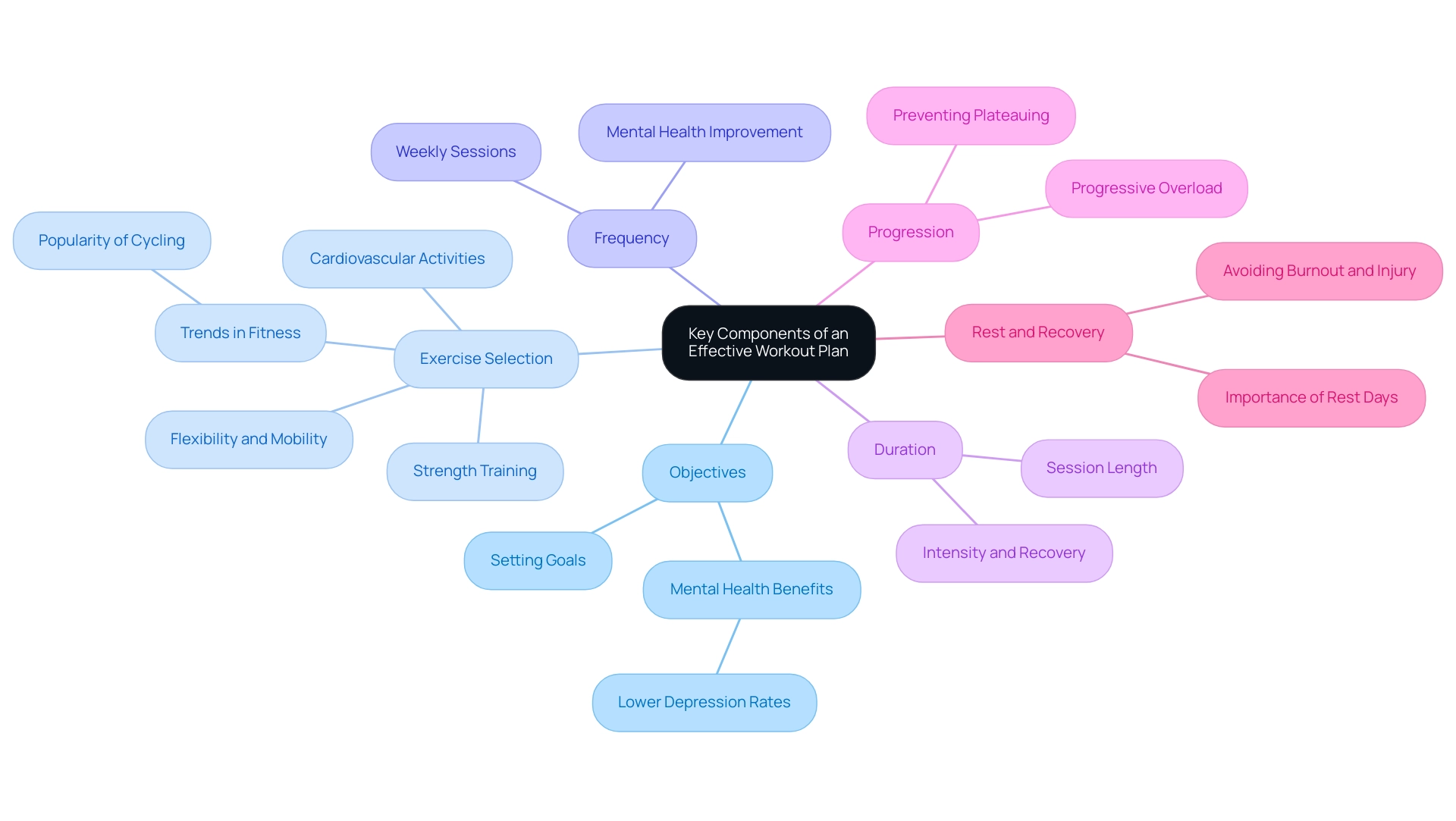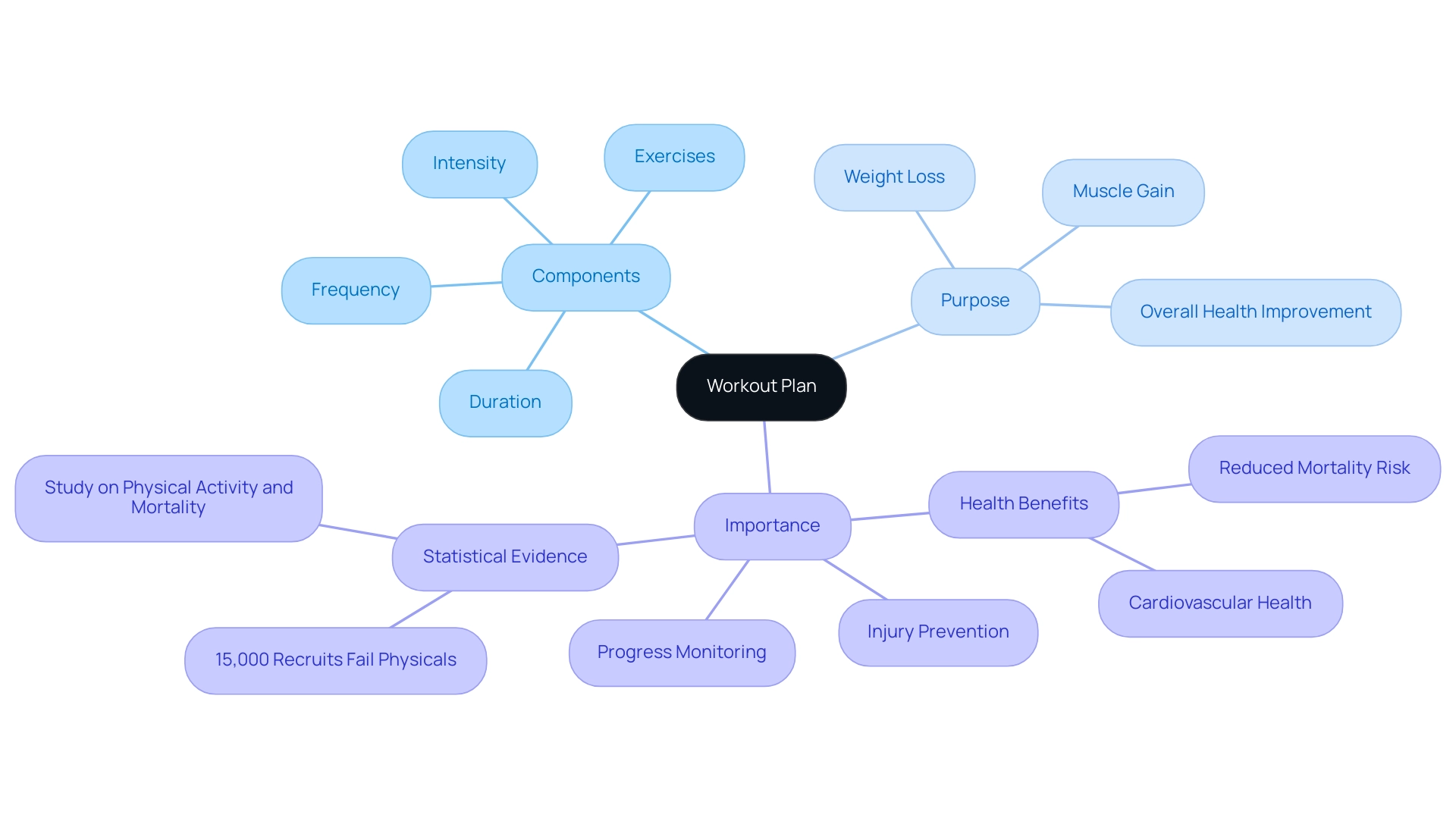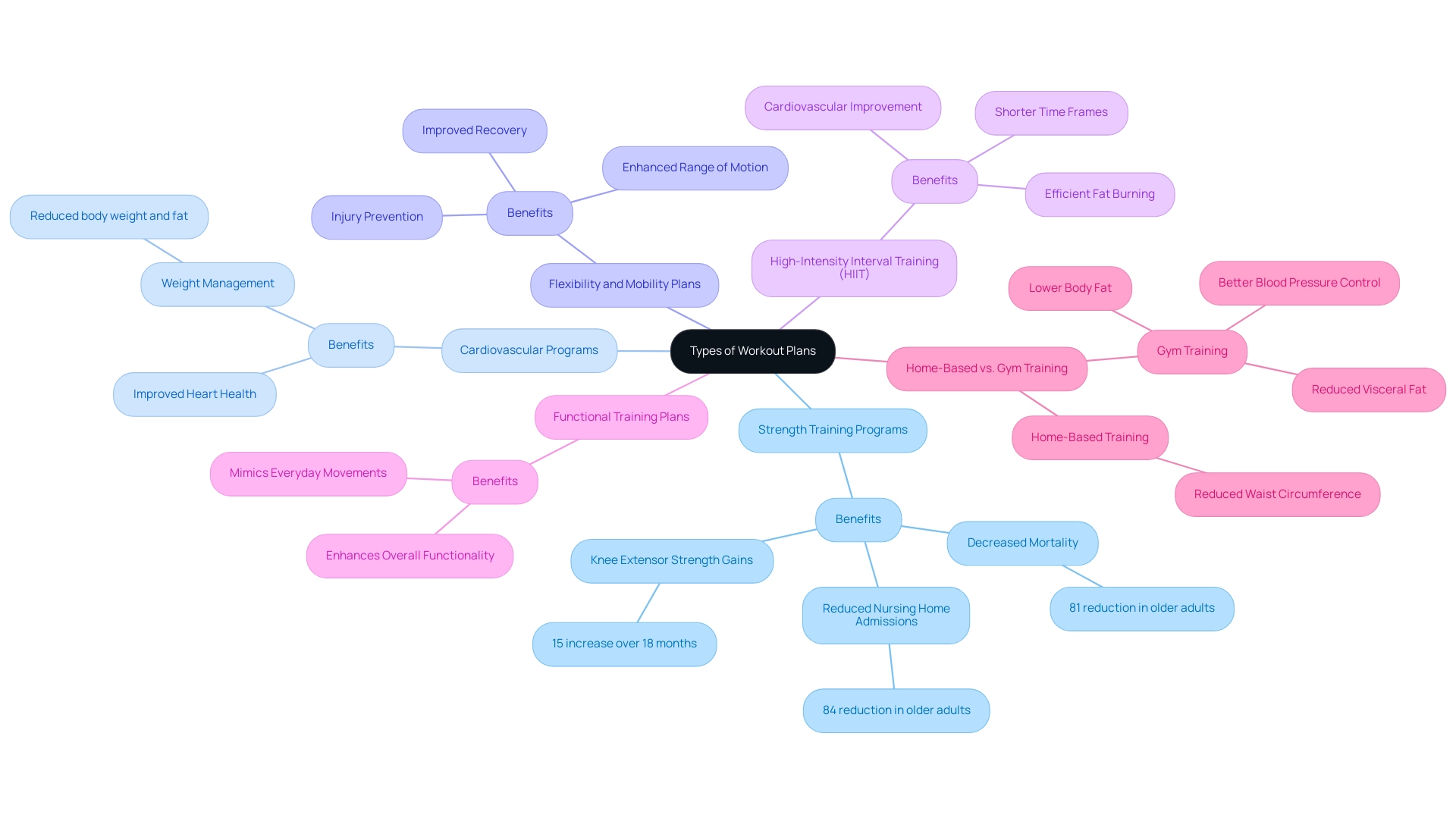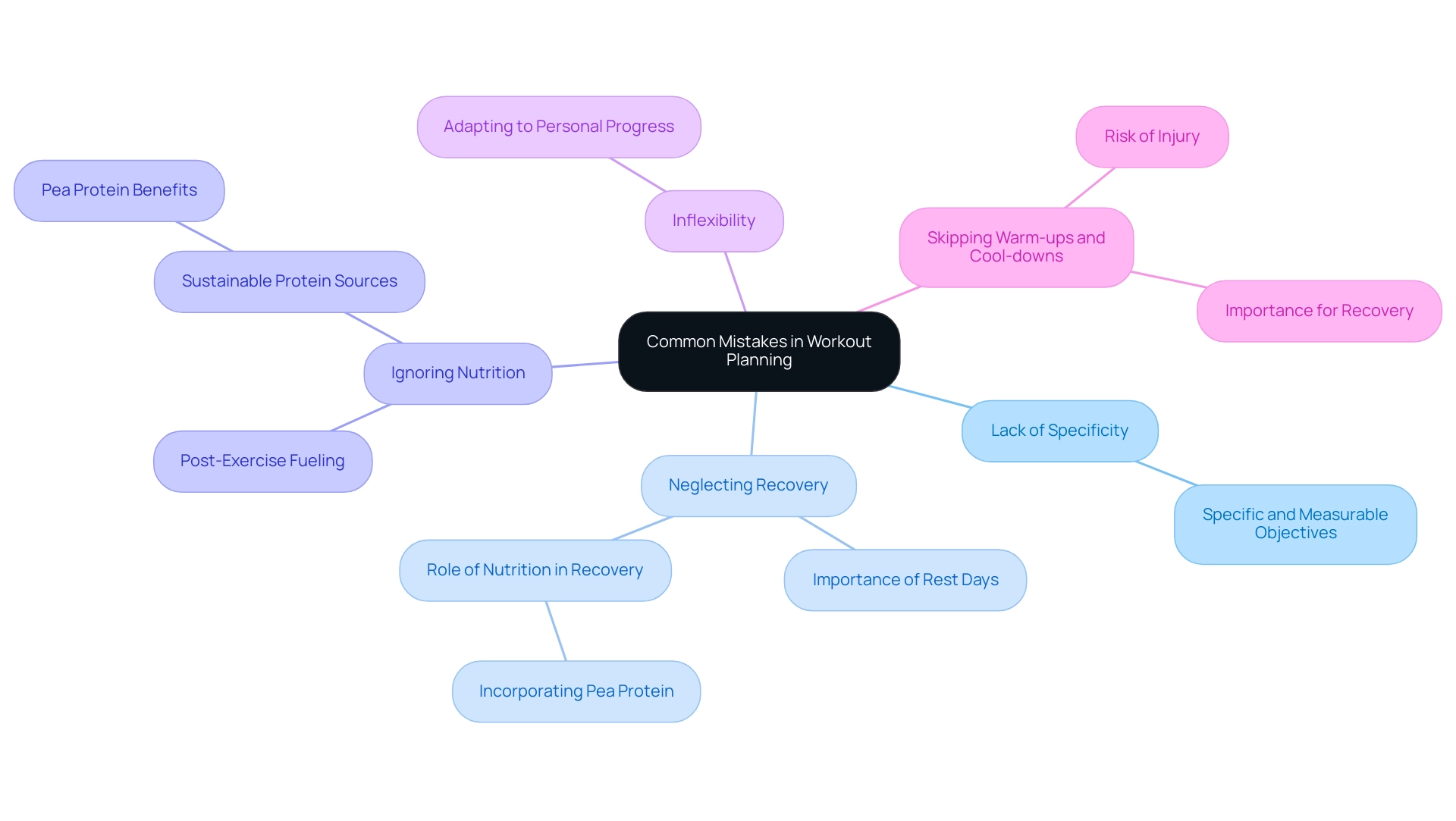Introduction
Creating a successful workout plan is essential for anyone looking to improve their fitness and overall health. This structured approach not only helps individuals set clear goals but also provides a framework for tracking progress and making necessary adjustments.
With alarming statistics highlighting the number of potential recruits failing physical assessments due to inadequate fitness levels, the importance of a well-defined workout plan cannot be overstated. From understanding the key components that contribute to an effective regimen to recognizing common pitfalls that can hinder progress, this article delves into the intricacies of workout planning.
By exploring various types of workout plans and emphasizing the significance of nutrition and recovery, readers will gain valuable insights into developing a personalized strategy that aligns with their fitness aspirations.
1. Defining a Workout Plan: Purpose and Importance
A workout plan serves as an organized framework that includes specific exercises, duration, frequency, and intensity customized to a person's health objectives. Its primary objective is to provide a clear roadmap in the form of a workout plan for those aiming to enhance their physical well-being, whether for weight loss, muscle gain, or overall health improvement. The importance of such a strategy is emphasized by concerning statistics, as around 15,000 potential recruits do not pass their physical evaluations each year due to insufficient conditioning.
A clearly outlined workout plan not only aids in progress monitoring and inspiration but also allows for informed modifications based on personal performance. Furthermore, by promoting safe and effective exercise execution, a well-organized workout plan plays a crucial role in preventing injuries, thereby becoming an essential element of any successful fitness journey. Evidence from a study involving 116,221 adults indicates that participating in physical activity beyond suggested levels significantly lowers the risk of death, reinforcing the significance of organized exercise routines.
As noted by Darren ER Warburton, studies consistently demonstrate that
regular physical activity is linked to a reduced risk of premature death, particularly from cardiovascular diseases. This evidence reaffirms the necessity of following a structured workout plan to ensure long-term health benefits. Additionally, insights from Thompson PD et al. concerning the acute versus chronic reaction to exercise emphasize how a structured method can result in sustained health improvements over time.
2. Key Components of an Effective Workout Plan
A successful exercise regimen consists of various essential elements that direct people toward reaching their health goals.
-
Objectives: Setting clearly defined health targets, such as increasing strength, enhancing endurance, or facilitating weight loss, is fundamental to shaping the structure of the strategy.
Studies suggest that people who establish specific goals are more inclined to achieve success in their exercise journeys. Furthermore, statistics show that women with moderate ambulatory levels (over 7,500 steps/day) have a 50% lower prevalence of depression compared to sedentary women (under 5,000 steps/day), underscoring the mental health benefits of regular exercise.
-
Exercise Selection: A well-rounded program should include a balanced mix of cardiovascular activities, strength training, flexibility, and mobility exercises.
This diversity not only encourages thorough physical development but also corresponds with the latest trends highlighting customized training plans suited to individual requirements. For example, the recent increase in the popularity of cycling, as noted by Statista, indicates a rising interest in various fitness methods that can be integrated into exercise planning.
-
Frequency: The frequency of exercise sessions per week plays a pivotal role in achieving desired results.
Evidence suggests that individuals engaging in moderate physical activity can significantly reduce the prevalence of mental health issues, illustrating the benefits of consistent exercise.
-
Duration: Each exercise session should have a predetermined duration that allows for sufficient intensity while providing adequate recovery. Establishing time limits helps maintain focus and motivation throughout the training process.
-
Progression: Incorporating progressive overload is vital for continuous improvement. As activity levels rise, increasing the intensity or complexity of exercises ensures ongoing gains and prevents plateauing.
-
Rest and Recovery: Prioritizing rest days and implementing effective recovery strategies is essential to avoid burnout and injury.
Maintaining long-term commitment to an exercise routine relies on balancing effort with recovery. The wellness market has experienced significant growth post-pandemic, yet many Americans face
barriers to regular physical activity due to time constraints and access to facilities. By incorporating these elements into a customized workout plan, people can adopt a systematic method that aligns with their health objectives while fitting their lifestyles, ultimately overcoming these obstacles.

3. Types of Workout Plans
Workout plans are diverse, with each one customized to achieve specific fitness goals. Understanding these categories can help individuals select a program that aligns with their objectives:
-
Strength Training Programs: These programs are designed to enhance muscle mass and strength through weightlifting and resistance training.
Notably, strength training has been shown to decrease mortality by 81% and nursing home admissions by 84% in older adults recovering from hip fractures. Additionally, an 18-month study demonstrated that knee extensor strength gains averaged 15% among older adults, highlighting the significant impact of strength training on overall health.
-
Cardiovascular Programs: Aimed at improving cardiovascular health and endurance, these programs focus on aerobic activities such as running, cycling, and swimming.
Such exercises are essential for maintaining heart health and supporting weight management. Recent studies indicate that regular exercise, including brisk walking, leads to reduced body weight and body fat among overweight and obese postmenopausal women, emphasizing the importance of cardiovascular activities alongside strength training.
-
Flexibility and Mobility Plans: These plans prioritize stretching and mobility exercises, which are crucial for enhancing range of motion and preventing injuries.
Incorporating flexibility work into a routine can also aid recovery and improve overall function.
-
High-Intensity Interval Training (HIIT): This approach involves alternating short bursts of intense exercise with rest periods, offering an efficient method for fat burning and cardiovascular improvement. Recent developments in HIIT have made it increasingly popular among fitness enthusiasts, as it can yield substantial results in shorter time frames compared to traditional cardio.
-
Functional Training Plans: These routines concentrate on exercises that mimic everyday movements, thereby enhancing overall functionality and strength for daily activities.
Home-Based vs. Gym Training: A recent case study compared the effectiveness of home-based exercises and gym training over a four-week period. Results showed that although both exercise types offer advantages, gym sessions resulted in decreased body fat and visceral fat, along with improved blood pressure management, while home sessions were more successful in decreasing waist circumference.
By examining these different exercise routines, individuals can create a workout plan that allows them to make informed choices about their fitness journeys, ultimately improving their health and physical abilities. As Gregory J. Norman from the Department of Family and Preventive Medicine at the University of California, San Diego, states, 'Understanding the various advantages of different exercise routines is essential for attaining optimal health results.
4. Common Mistakes to Avoid in Workout Planning
Creating an exercise plan can be significantly hindered by several prevalent mistakes that impede progress:
- Lack of Specificity: Goals that lack clarity can result in unfocused training sessions. Establishing specific and measurable objectives is essential for achieving desired outcomes.
- Neglecting Recovery: Failing to incorporate adequate rest can lead to overtraining, burnout, and injuries. A balanced exercise regimen must include designated rest days to facilitate recovery, during which nutrition plays a vital role. Incorporating pea protein as a plant-based source of protein can aid in muscle recovery, ensuring your body receives the nutrients it needs to rebuild.
- Ignoring Nutrition: A well-structured workout plan is incomplete without a complementary nutrition strategy. As emphasized by nutrition expert Crewe,
Your workout sessions put stress on your body. It needs proper fuel in order to recover from that stress and grow stronger — so skipping food post-exercise will only work against you.
Pea protein, with its similar nutrition profile to animal proteins, is a sustainable and ethical option that supports muscle growth and recovery, enhancing overall fitness goals.
- Inflexibility: Adhering strictly to a predetermined strategy without accommodating personal progress or lifestyle changes can lead to frustration. Embracing flexibility in planning is vital for long-term success.
- Skipping Warm-ups and Cool-downs: Overlooking the importance of these components can increase the risk of injury and hinder recovery. Incorporating suitable warm-up and cool-down exercises is essential for a safe and effective exercise routine.
By recognizing and addressing these common mistakes, individuals can enhance the effectiveness and sustainability of their workout plan. Furthermore, integrating pea protein can provide additional energy, focus, and muscle recovery benefits, ultimately improving adherence rates, which are reported at an overall mean of 66% in exercise intervention literature. The study by Woolf-May et al. in 1999 underscores the significance of structured approaches to physical activity, as it found no significant differences in adherence rates, highlighting the necessity of avoiding pitfalls in exercise planning.
How to Incorporate Pea Protein:
- Post-Exercise Smoothie: Blend pea protein powder with fruits, spinach, and a nut butter for a nutrient-rich recovery shake.
- Protein Coffee: Mix pea protein with your morning coffee for an energy boost while ensuring muscle recovery — try our 'Buy Protein Coffee - Risk Free' option!
- Meal Additive: Stir pea protein into soups, stews, or oatmeal for a protein boost at any meal.
Frequently Asked Questions about Pea Protein:
- What are the benefits of pea protein? Pea protein aids in muscle recovery, provides energy, and is a sustainable alternative to animal proteins.
- How can I use pea protein? It can be added to smoothies, baked goods, or consumed as a protein shake.
- Is pea protein suitable for everyone? Yes, it is vegan-friendly and suitable for most dietary needs, but always consult a healthcare provider if you have specific concerns.
5. Tracking Progress and Making Adjustments
Monitoring progress is crucial for sustaining motivation and ensuring the effectiveness of a workout plan. Effective strategies for tracking progress include:
- Regular Assessments: Conduct physical evaluations at consistent intervals to quantify improvements in strength, endurance, and flexibility. This systematic approach provides valuable insights into one's physical capabilities over time.
- Workout Logs: Keeping a detailed record of workouts—documenting exercises performed, weights lifted, and session durations—allows people to identify patterns and improvements in their performance. Research has demonstrated that people who maintain exercise records are more likely to reach their health objectives, underscoring the significance of this habit. As the saying goes, "And of course, there's an app for that," highlighting how mobile apps increasingly facilitate such logging.
- Body Measurements: Tracking metrics such as weight, body fat percentage, and circumferences offers a tangible way to gauge physical changes and overall health progress.
- Adjusting Goals: As individuals achieve milestones, it is essential to revisit and modify fitness goals to ensure continued personal challenges and prevent plateaus.
- Listening to Your Body: Being attuned to physical responses during exercise is vital. Identifying signs of exhaustion or unease may suggest the necessity to modify the exercise routine for optimal safety and performance.
By employing these tracking methods, individuals can stay aligned with their health objectives and make informed adjustments to their workout plan. Such practices not only facilitate ongoing progress but also enhance overall involvement with health. Furthermore, insights from the case study titled "
Implications for Mobile Health Technologies" suggest that mobile apps and fitness trackers can effectively promote physical activity, particularly during health crises like COVID-19, emphasizing the need for personalization and adaptability in tracking methods.
Conclusion
A well-structured workout plan is a foundational element for anyone seeking to enhance their fitness and overall health. By defining clear goals, choosing appropriate exercises, and establishing a balanced routine that includes frequency, duration, and progressive overload, individuals can effectively work towards their fitness aspirations. The importance of integrating nutrition and recovery strategies further emphasizes the holistic approach required for success in any fitness journey.
Recognizing the various types of workout plans allows individuals to tailor their fitness strategies according to their specific objectives, whether that be:
- Strength training
- Cardiovascular fitness
- Flexibility
Understanding and avoiding common pitfalls—such as neglecting recovery, ignoring nutrition, or failing to track progress—ensures that the workout plan remains effective and sustainable over time.
Ultimately, commitment to a structured workout plan not only facilitates physical improvements but also contributes significantly to mental well-being and long-term health. As individuals embrace this structured approach, the potential for achieving fitness goals becomes not just a possibility, but a reality. Prioritizing a well-defined workout regimen is essential for anyone serious about enhancing their quality of life through fitness.


































